DIY Synth Page 2:
Digital
Expanding the
Analog Eurorack synth into the digital domain
The
Schematics, PCB files, and Simulation models are here
Back to the analog part
I put down the synth
project for the summer and fall of 2016 while some interesting
things happened. I learned to use DipTrace. Now instead of doing
board layouts in the proprietary ExpressPCB, I use DipTrace
instead, a nice full-featured CAD Schematic and PCB layout tool.
It is low cost (free for simple boards) and easy to learn, but
powerful. It generates Gerber files, pick and place files, and
other manufacturing files, Unlike ExpressPCB, which generates none
of these files and requires that you purchase boards only from
ExpressPCB. Back in the early days, the ExpressPCB boards were low
cost and simple. Nowadays, they are no longer the low cost
supplier since there are several low-cost, mostly Chinese PCB
manufacturers.
I also considered Eagle, Altium, and KiCad. I personally cannot
stand the Eagle user interface. I've tried, but no. Too many
non-intuitive mouse clicks cause parts of my brain to fight it.
Altium's free version (Circuit Maker) requires that you share all
designs on-line and I had trouble creating new library components
with it. KiCad is OK, but I was able to learn DipTrace much faster
than KiCad. I manually converted an old PCBExpress board to
DipTrace and it went very well. So Diptrace it is. In the past
year I have laid out about 10 designs, and built 6 of them. I
order boards from PCBWay (low-cost Chinese supplier) and Advanced
Circuits (more expensive and faster American supplier).
Teensy Audio
I also discovered Teensy
processors at https://www.pjrc.com/. These low cost modules use
the Arduino development tools, come in convenient and small DIP
packages, and have processors ranging from the Atmel 8 bit to
200MHz ARMs. The one I like is the Teensy 3.2, 72 MHz arm
processor. In addition to having many excellent code libraries and
examples, the designers, Paul J Stoffregen and Robin C Coon,
developed a very cool audio library and hardware audio interface
that can generate and process CD quality audio along with their
Teensy Audio Board. And even cooler, applications using the audio
library can be programmed using a nice simple graphical
programming tool that takes care of many real-time audio tasks
like digitizing, recording and playback, filtering, effects,
waveform and musical instrument synthesis, and many others. Buy a
Teensy 3.2 , and an Audio board, and have some serious nerd fun.
Really, this is the first time that a hobbyist or Arduino person
can build meaningful, real-time CD quality audio DSP applications.
Very cool.
My first Teensy audio project was to load up and run Peter
Teichman's roto2, an small simulation of a Hammond drawbar organ.
It works swell. He nicely addressed the ability to use USB midi,
build a 8x polyphonic instrument using the basically monophonic
Audio Library, and built an excellent vibrato module. Here is a
demo of roto2.
I wanted to add regular old 5-pin MIDI to it and it was pretty
simple to do so. The callback function for MIDI and USB MIDI are
about the same. I searched for a 4 octave keyboard with 9 sliders
that could be used to control the Hammond drawbars. I settled on
the $120 M-Audio Oxygen49 keyboard, and it turns out it is a USB
only device, no 5 pin MIDI. I learned that most newer low-cost
keyboards don't have a Midi connector. When I looked up Midi
USB converters, I found a very cool Midi USB Master from the nice
people at HobbyTronics. This little board acts as a MIDI host to
USB adapter for $15. This worked swell. Here is my full
Hammond organ prototype with USB Midi master. Teensy is mounted
above the audio adapter, the 3 wire cable is the stereo audio
output. This setup is powered by the Teensy USB connection which
is also a USB serial port for debug, as well as the Teensy
download port. The board with the blue LED is the USB master,
which is driving the Oxygen 49 Keyboard. On the right I show the
HobbyTronics Midi adapter which also works fine, but I'm not using
it at this time.
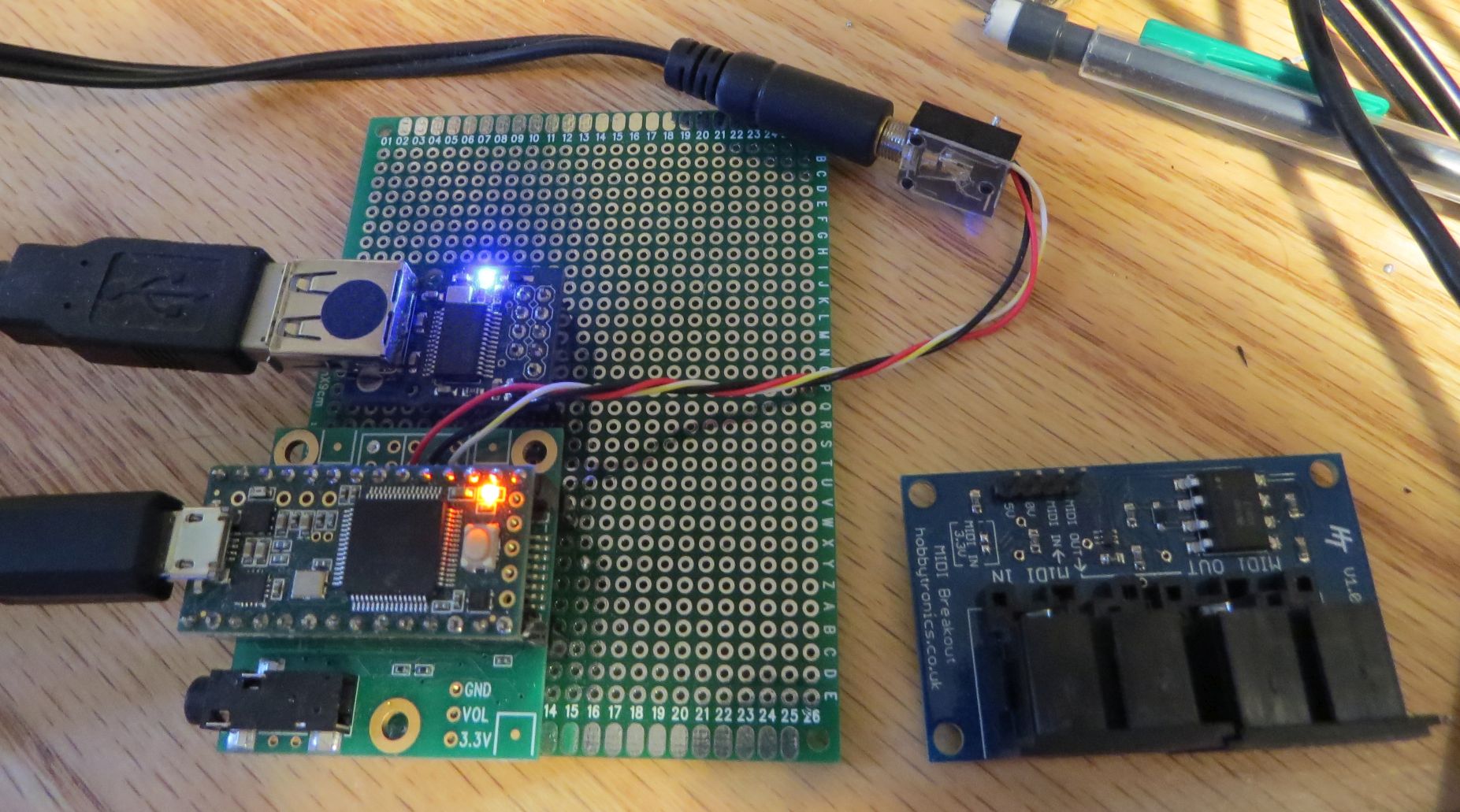
Ornaments & Crime
While messing with
Teensy, Steve turned me on to a cool open-source synthesizer
module called Ornaments
& Crime, a very clever analog synth control voltage
processor. It has about 10 powerful operating modes, each with
many parameters. It can be a powerful multi-channel quantizer, can
generate many different mathematically and sonically interesting
control voltages and sequences, and has a mode with quad Turing
Machine sequencers.
I ordered O&C boards and panels, plus the various components,
and build it from instructions on-line. It is very powerful. It
sports 4 16 bit DACs to generate very precise CVs. It has a nice
User Interface (UI) using a bright blue OLED graphic display and
two encoder knobs. It takes a bit of menu diving to get at the
settings, but the UI is well done and intuitive.
The parts are mostly 50 mil pitch ICs and 0805 passives, with a
few tiny exceptions so building is fairly easy for someone
experienced with SMT. It was pretty easy to build, install the
code from Arduino, and calibrate. Runs great. I built 2, one for
me and one for friend Steve D.
The challenge I had building O&C was to find the exact right
1.3" OLED. Unfortunately the pinout that the designers selected is
pretty rare and must be ordered from China. I ordered 2 of the
wrong ones, waited until they arrived from China, realized my
mistake, and then ordered the right ones from Ali
Express. Meanwhile I built a simple wiring adapter so I
could temporarily plug in the incorrect OLED. The panel won't fit
this way though. When the right OLEDs arrived, they plugged in and
worked swell. I like the super high contrast of the blue OLEDs.
Here is O&C running the 1.2 firmware with the excellent
sequencer.
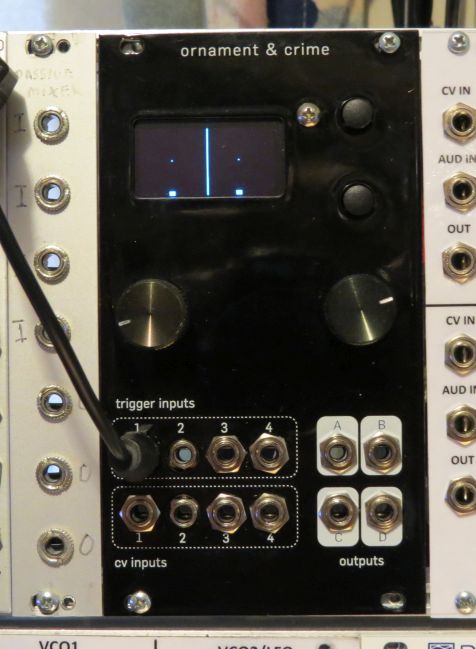
DIY Braids
Braids is a Eurorack
"Macro Oscillator" designed and sold by Mutable Instruments. They
bill it as capable of replacing a rack full of analog gear. It has
dozens of different and interesting waveforms available, and each
type of waveform can be modified by either knob or CV to affect
its pitch, FM, "Color" and Timbre". It also has an envelope
generator included. Steve uses a Braids as his main oscillator and
I have wanted to play with one. I couldn't bring myself to pay
$400 just to play. Since the design is open-source, and boards,
panels and firmware are all available, so I built up a couple.
Armed with the experience of building someone else's
microprocessor-based Eurorack modules (O&C), I found some
clone Mutable Instruments Braids boards for $7, the panels for
$30, and the other parts for about $60. Ideally you install the
development tools, build (compile) and program the firmware, but I
was put off by a statement on the Mutable Forum that the build
process is difficult under Windows. Step 1: Install Linux. Step 2:
install many development tools.... I located a pre-built
version 1.5 on-line which worked perfectly. Then I used the
excellent Mutable Instruments update facility to update the module
to the latest, v1.8. I already had a programmer for the STM32F
processor, and needed only a $12 adapter for the tiny JTAG
header.
Braids uses several fine-pitch parts and 0603 discrete components,
so I don't recommend it as a first surface-mount project. Get
comfortable with 0805 soldering first before you attack your first
0603 project. Me, I'm pretty good at SMT hand assembly and had no
trouble building the boards.
The only tricky part of Building Braids is that the encoders that
Mutable uses are a special order and so not available. Encoders
have many, many options: Pulses per rotation, pulses per click,
click or no click, pinout, rotation direction, shaft length and
type, bushing length and type, Turns out that the two big encoder
suppliers, Panasonic and Bourns generally rotate in opposite
directions. This can be fixed in firmware if you can compile the
firmware. I couldn't find a compatible Panasonic part, but I found
a similar TT part EN11-HSM1BF20 that works fine.
Here is DIY Braids.
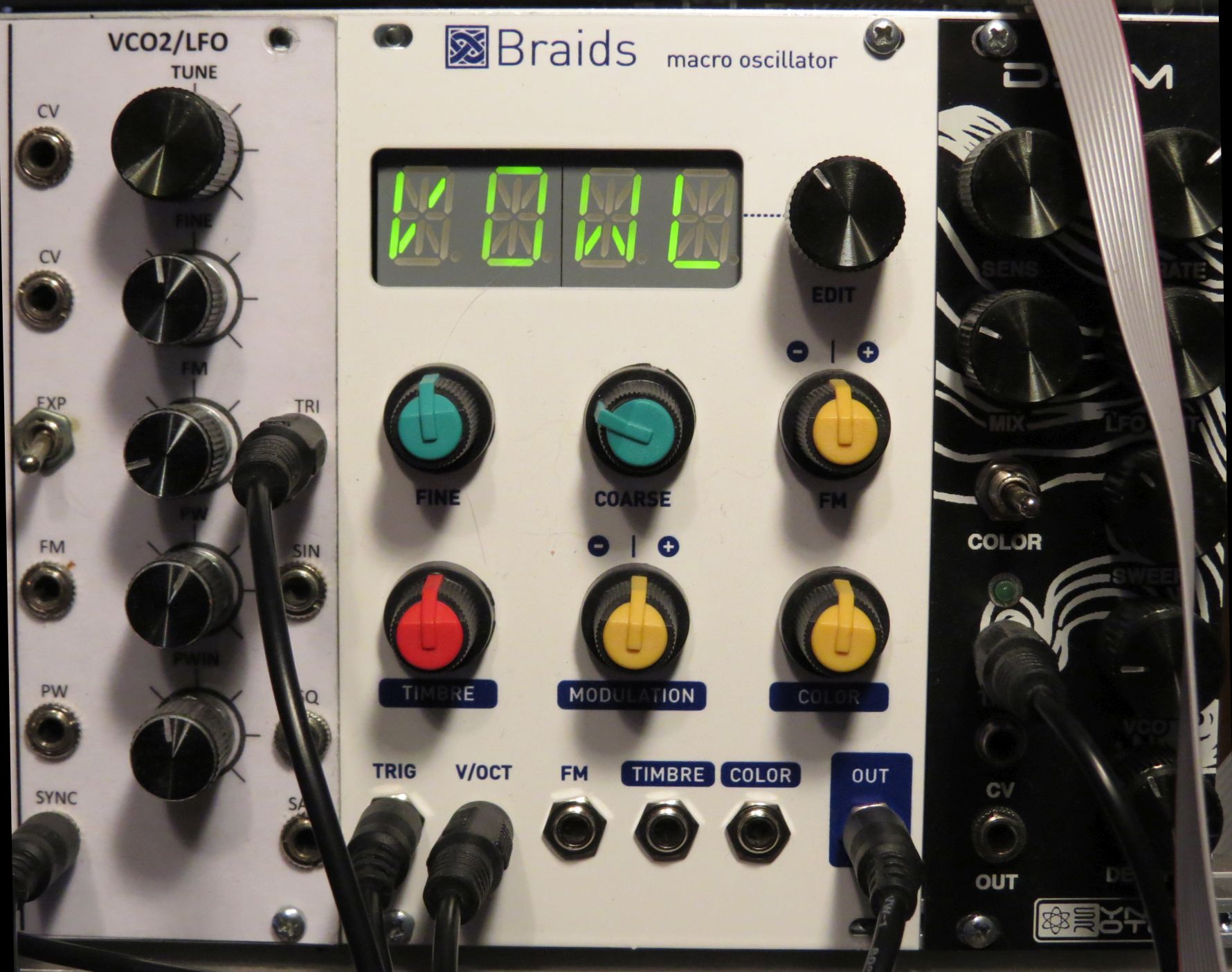
Synthrotek 07'
Buffered Mult
With all these new
trigger and CV inputs (4 VCOs, Braids, O&C, Turing Machine,
Drum machine, CV-> Midi) I was struggling with how to get
inputs to all these modules. Fortunately Synthrotek came to
the rescue with the '07 MULT, a nice low cost and very dense
buffered Mult. It makes multiple copies of up to 4 control
voltages or trigger signals, and it does it precisely using TL07x
op-amps. And it is low cost. I paid $25 for the boards and front
panel, about $10 for the 18 jacks, and had the rest of the ICs,
caps, resistors in my stock. I had it built up in about an hour.
Here it is in all its dense wiring glory.
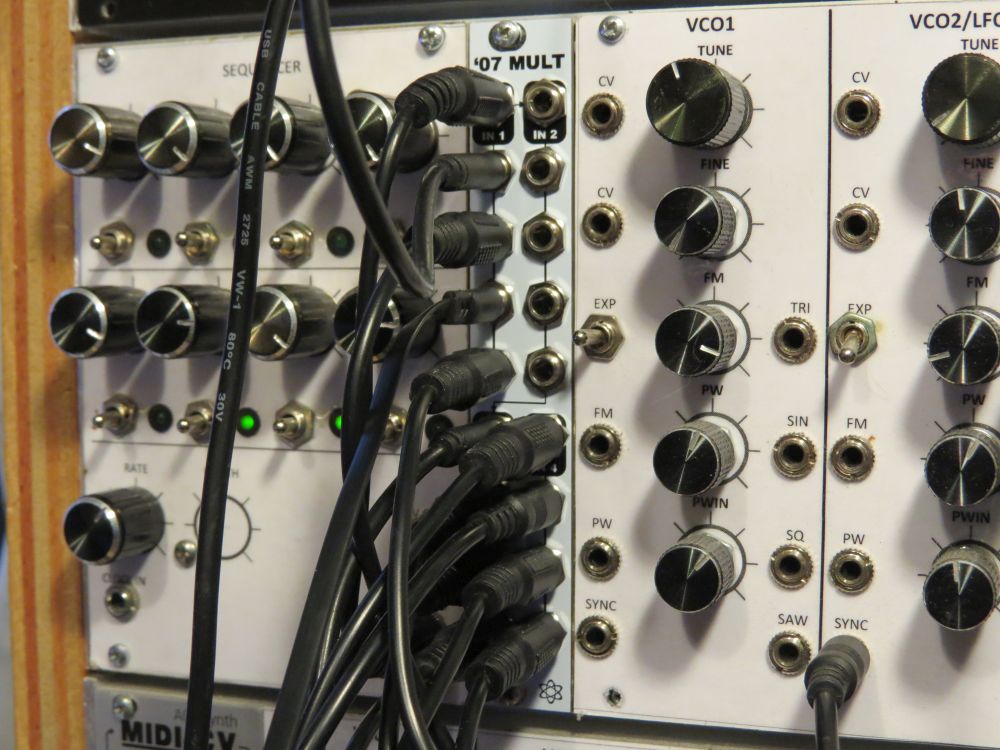
New Drum machine
I wanted a flexible and
good sounding Drum machine with a sequencer. I considered
Eurorack, but a Eurorack full drum set gets expensive quickly and
takes a bunch of rack space. I had a big Yamaha Midi Drum
machine, but it was too big for my space. The Korg Volca Beats has
all I wanted in a low cost $150) and small package. It
accepts an external trigger to keep the beat with an analog synth.
And it it fun to setup and make beats. I plan to allow
hardware triggers of individual drums by building a CV and Trigger
to Midi circuit out of an Arduino. Damn, this thing needs a good
cleaning!
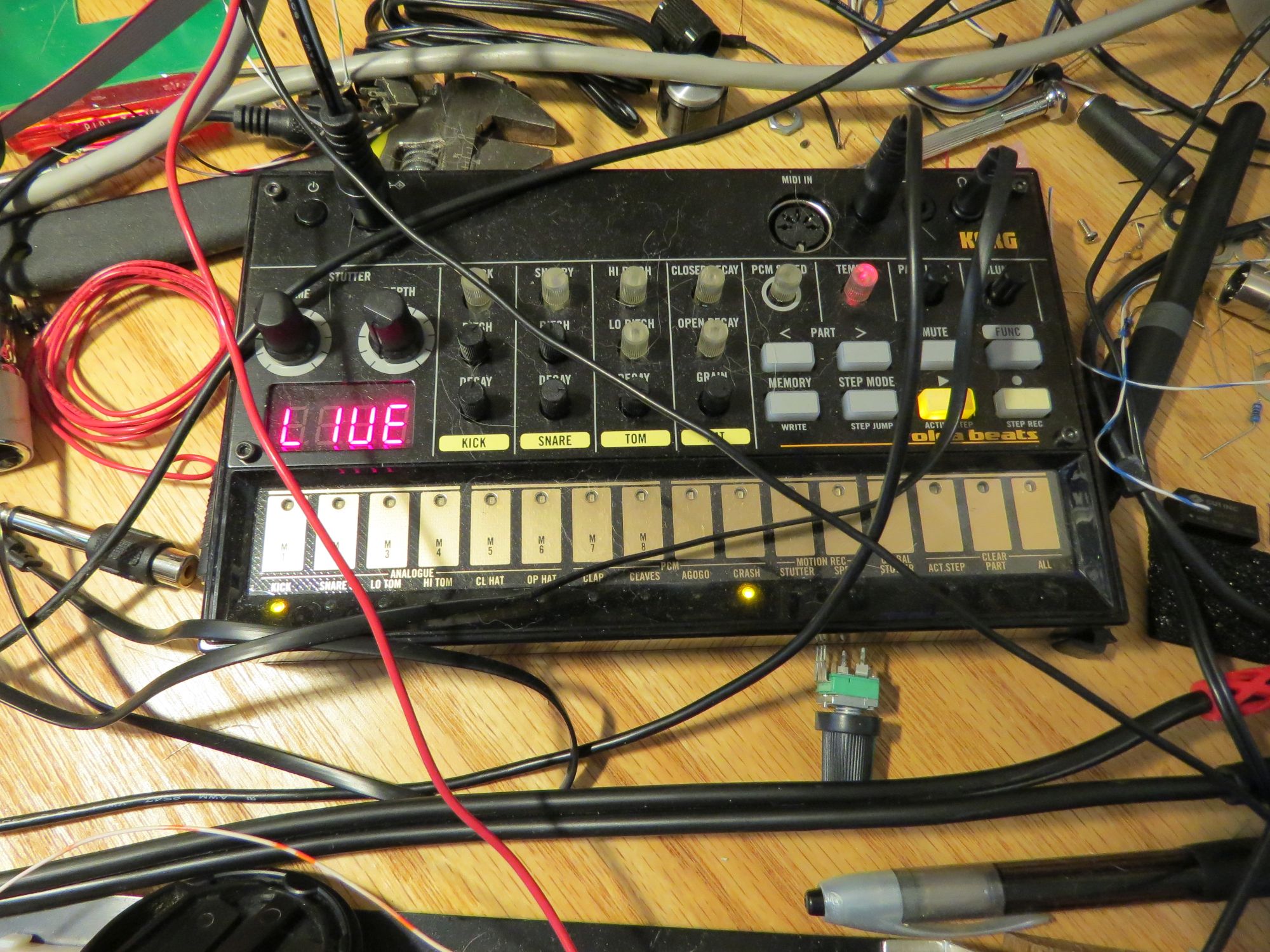
In 2021 I finally gave up on the Korg Volca Beats, and sold it on
Ebay. My latest sequencer is the Arturia BeatStep pro, which has
one of its 3 channels set up for Drums. It outputs drum triggers,
but for now I have given up on Eurorack Drums. I use a cheap and
small digital Midi Drum machine, the Zoom Rhythm Rrack RT-123.
Works great, has litle drum pads, is velocity sensitive, and has
more drums than I can think about. it's a good match for the
BeatStep PRO.
Mutable Elements
Clone
The compiled firmware
(.BIN file) for Mutable's "Elements" is available on-line. Boards
and front panels are also available. I wanted to play with
the physical modeling of this device.
I ordered 3 boards, panels and set of parts, and built them up for
myself and 2 of my synth buddies. Another nice STM32 design, so I
had the programmer and software to load the firmware. Lots of
soldering, but well worth the work.
What fun! This crazy beast has 27 control pots and 17 control
inputs, yikes! I am fascinated by bell sounds and this has them.
As well as bowed and blown instruments. So powerful!
I would have slightly preferred a Mutable "Rings" which is smaller
and more bell-like sound. But I couldn't find the compiled .BIN
file for it.
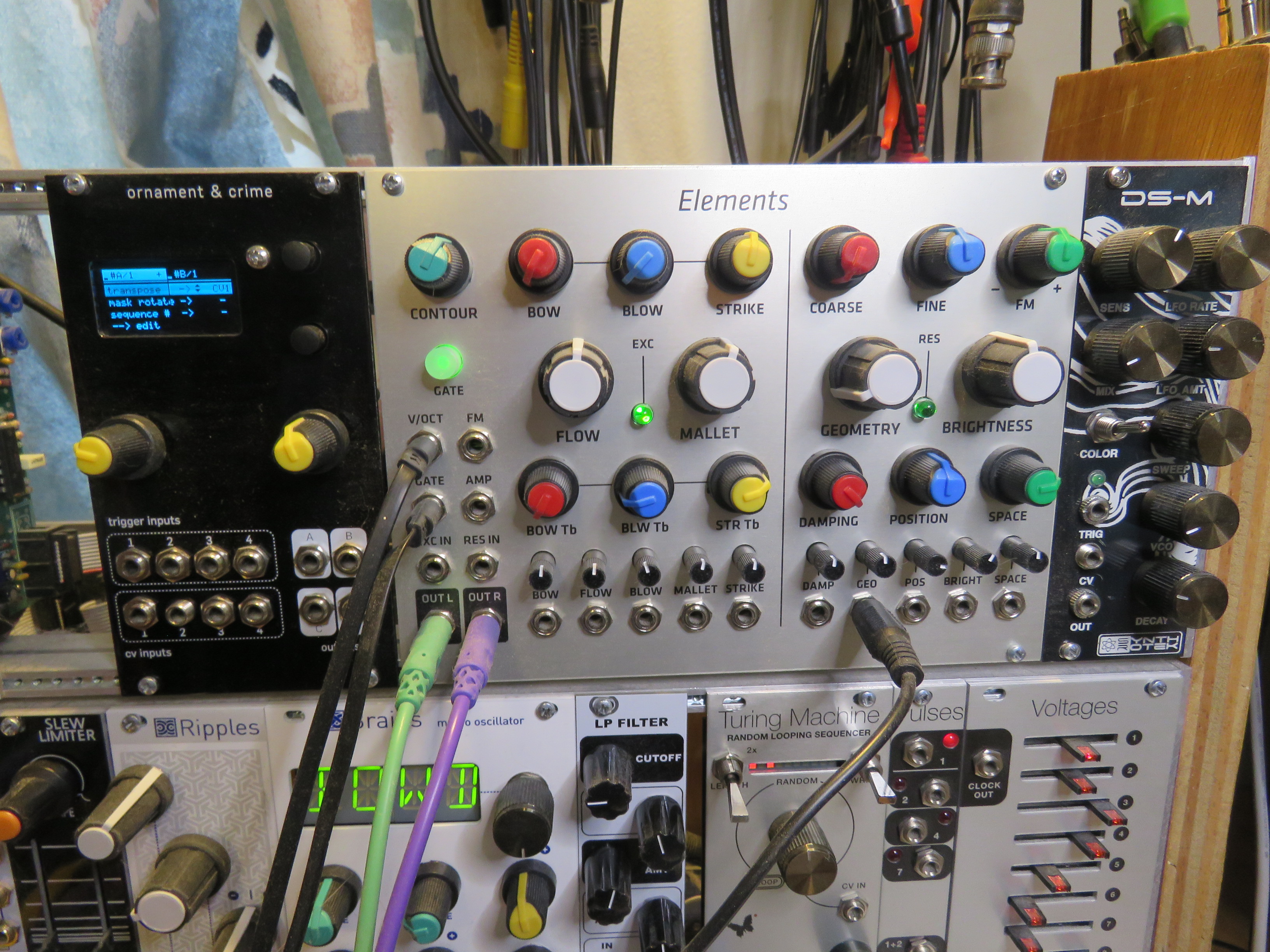
Mutable Ripples
Filter
I wanted to play with
some other filters. Up to now, my only VCF was a Synthrotek LP
Filter. Ripples is a 4 pole (24dB) based on the SSM2164 quad VCA
chip. I stole the design for Polysynth, then it showed up again
when I built 6 of thee filters for Ambika.
Other Stuff:
Befaco Slew Limiter
(Glide)
A glide is a slew rate limiter for Control voltages. I love the
glide effect and wanted to try one. Befaco has panels, Boards and
schematic available. This one works very well, and you just push
the slide pots to the bottom to reduce the time to 0, effectively
bypassing the function. I use it mostly for my main CV from Midi.
Doepfer A143-3 Quad LFO
Steve gave me this one. It's a great way to provide up to 4
separate wide range LFOs, each with TRI, SQU and SAW outputs. It's
a clever design with 4 little boards. They connect via the power
cable, with 4 connectors crimped onto it. One channel was
broken. It was one of the power connectors.
Doepfer A160 Clock Divider
Another gift from Steve, very handy for driving your
sequencers.
2022 Update
Here is my current system, 3 racks high. Despite retirement, I
have been involved in many other projects and Synth play has taken
a back seat. The grand-kids do enjoy banging on the keyboard and
making crazy music though.
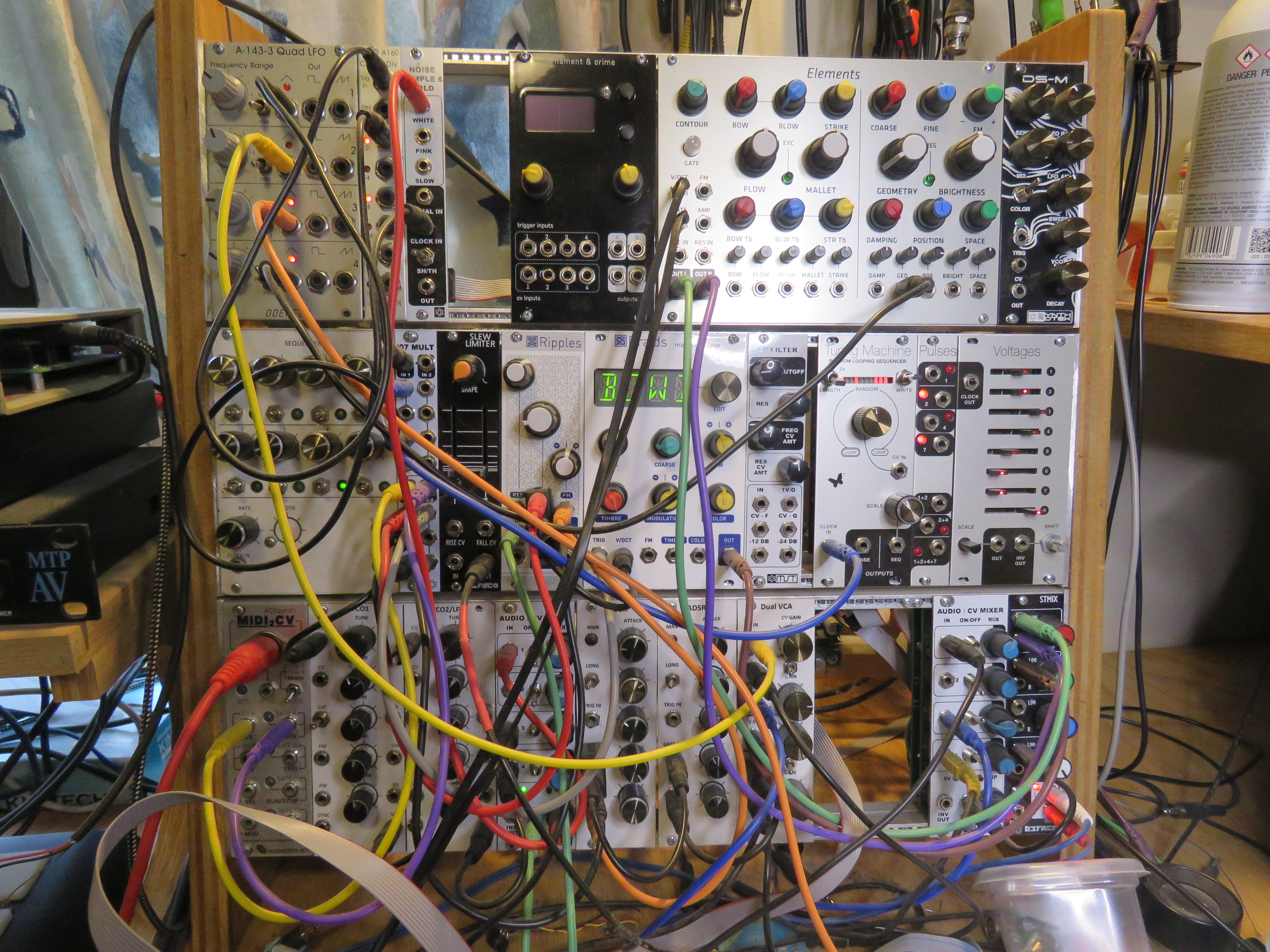
Other synth goodies
I use an old Yamaha TG100
as my basic piano. It has the usual 100 MIDI standard instruments.
It is small, simple, polyphonic, and reliable. As usual, I had to
repair it. The 7809 9V regulator was blown.
I built a DIY Hammond Organ based on a Teensy 3.5 and designed by
Brian Millier, from a Circuit Cellar article. Love that Hammond
organ sound, but I live in way too small a house to own a real one
so a little 8" box is a reasonable alternative. If it looks
like an old white modem box, it is.
I have had a few keyboards and midi sequencers. Right now I use
Arturia Keystep and BeatStep Pro. An obvious replacement for these
is the newer and more powerful KeyStep PRO, but it's $400.
My main keyboard is an M-Audio Oxygen49, because it has tons of
controls including the sliders that the Hammond Organ needs to
simulate the drawbars. Unfortunately it has no real MIDI 5-pin
connector, so I use a DIY USB to MIDI converter, installed in the
same box as the Hammond.
With all this MIDI stuff, I considered building a small MIDI
distribution / crosspoint. But Steve to the rescue, he handed me
an old Mark of the Unicorn MOTU MTV-AV Midi 8x8 crosspoint. It
makes perfect glue for all the MIDI stuff.
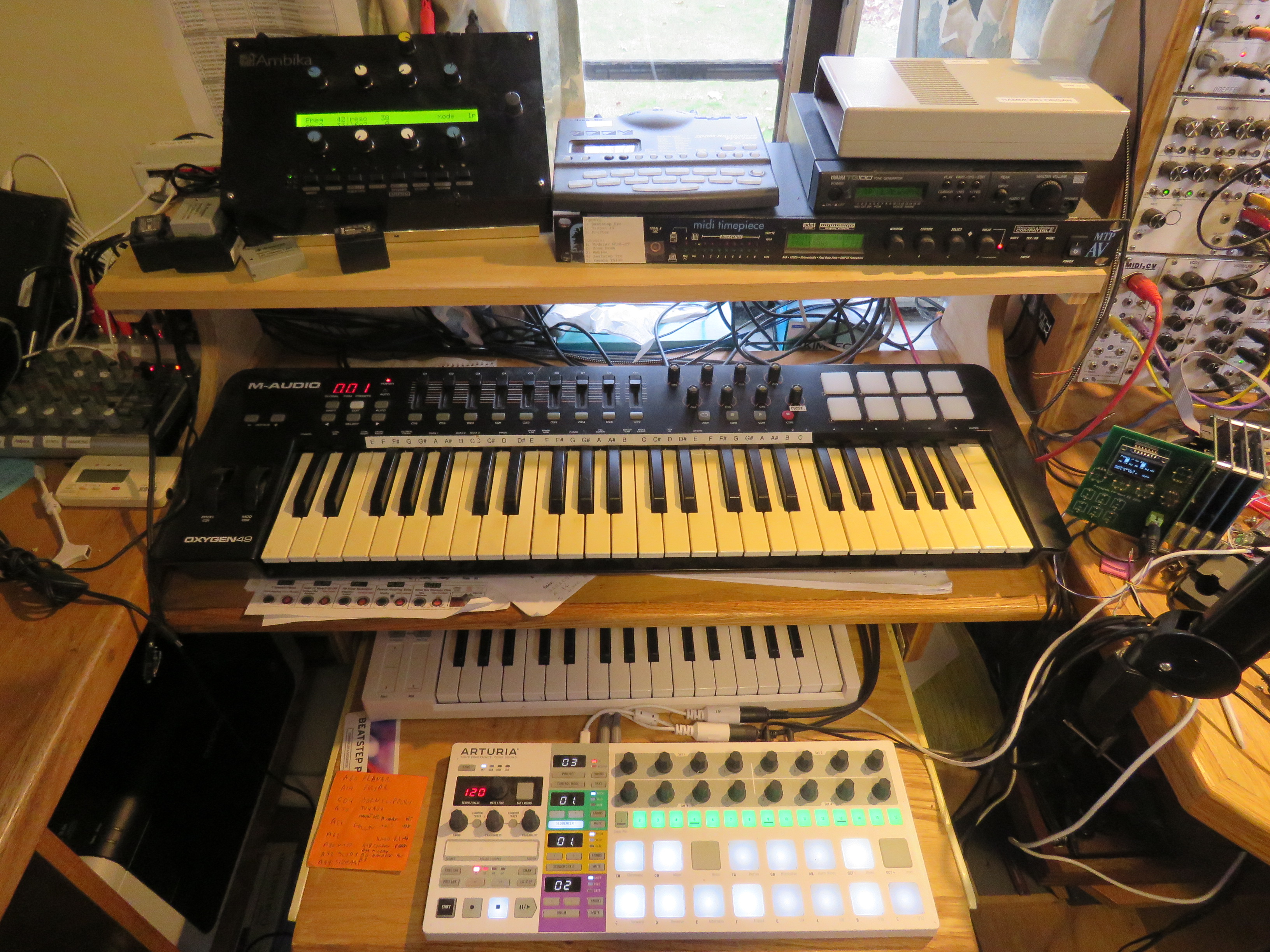
Back to
Page 1: Analog
Forward to Page 3: OLEDs and CV-> Midi
Dave's Home Page
Last Updated: 12/3/20222




